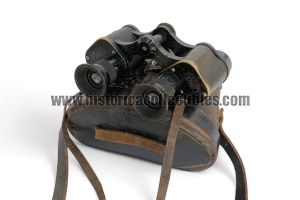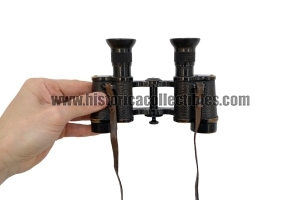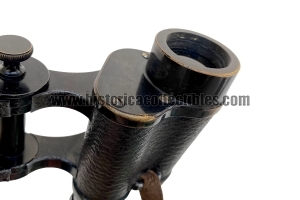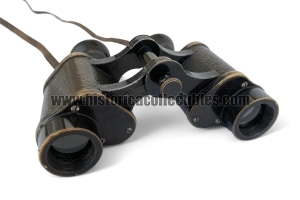Feldstecher 6 Fach, Carl Zeiss, 1st Series of the New Generation, 1907
Feldstecher 6x21 produced by Carl Zeiss of Jena in 1907. This particular model has notable characteristics that differentiate it from all other "feldstecher" binoculars. This is the model that is part of the first series of the new generation of Feldstechers. In fact, in August 1907, in the Zeiss T74 brochure, a new generation of binoculars was presented. The old binoculars with screwed "lid" and objective lens plate have been replaced by the new binoculars with a bridge cast in one piece.
A completely innovative model compared to its predecessor, in fact the characteristic of the innovations lies in the mechanically and optically improved construction. The body of the binoculars was cast in one piece with the bridge arms and strap eyelets. The housing covers extend over the housing and are sealed with a special grease. The optics are now also collimated via the objective lenses, via a double eccentric adjustment. The serial number is located on the edge of the right objective plate (low 5-digit serial number).
Optical improvements include improved light intensity, increased image sharpness right up to the edges and an expanded field of view. There are also two other details that lead it back to a first series as the bakelite eyepieces and the mechanism for tightening the interpupillary distance have remained unchanged. Only after several years were they improved aesthetically and mechanically to facilitate their use. An unusual and very rare binocular that fully demonstrates the continuous evolution of the optical-mechanical field.
The binoculars are in excellent condition, with original shoulder strap. The view is perfectly collimated, sharp and all the mechanisms work precisely.
Complete with its original case with shoulder strap.
Carl Zeiss takes its name from its founder, Carl Zeiss, who on November 17, 1846 chose the small city of Jena, in Thuringia, as the location for his precision optical equipment factory. Thanks to the strict quality control that Carl Zeiss imposed on its products, going so far as to personally destroy the microscopes that did not pass the tests, the newborn Zeiss became the official supplier of the University of Jena and received the gold medal of the industrial exhibition in 1861 of Thuringia as the best research instrument manufactured in Germany, awarded to the microscope Stand I of 1857.
In 1866, the thousandth microscope was produced and the Zeiss name became known in all European scientific circles. Thanks to the studies on the Porro prism, in 1893 Abbe patented a double prism binoculars, which accentuated the perception of depth.
The mass production of Zeiss binoculars began in 1894, already at the beginning of the twentieth century more than 30,000 were made, by the beginning of the First World War the figure had risen to 500,000 and, by the end of the Second World War, 2,260,000 were produced binoculars for the civilian and military market. Models were made starting from 4x11 mm to 12x40 mm, up to real giants such as 80 mm and 100 mm.
Thanks to studies conducted on the perception of light in low light situations, it was shown that the average dilation of the pupil in an adult is about 7 mm. For this reason, the 7x50 mm model was introduced in 1910 and remained on the market until 1917 with few changes to the materials used.
In 1926, following the post-war crisis of the First World War with the Treaty of Versailles which bankrupted many important German companies, Zeiss bought the "C.P. GOERZ" and founded the Zeiss Ikon in 1926.
In 1937, Zeiss had commercial contacts and factories spread over 29 countries around the world. From 1933 Zeiss acquired interest from the Nazi regime, which balanced production towards military instruments. It successfully produced binoculars with wide-angle optics for military use, pressure resistant optical systems for U-boats, periscope binoculars for targeting tanks. Furthermore Zeiss cameras were mounted on the V2 for remote sensing operations of the English coasts.
On November 1, 1935, Zeiss, in the person of Alexander Smakula, patented a process for the treatment of optical glasses with extraordinary results in terms of light transmission. Remained a military secret until 1939, it was adopted on binoculars to reduce ghost images and internal reflections. During the Second World War, there were numerous bombings against the Zeiss factories.
Jena was bombed several times by the Allies starting in 1944. Stuttgart was razed to the ground, although the Contessa-Nettel factory suffered little damage. The bombing of Dresden, in addition to devastating the city, also caused considerable damage to the Zeiss Ikon headquarters.
On April 13, 1945, American military forces entered Jena, surprising themselves as the bombings had not caused significant damage. The main planetarium was in ruins, while the factories remained operational.




